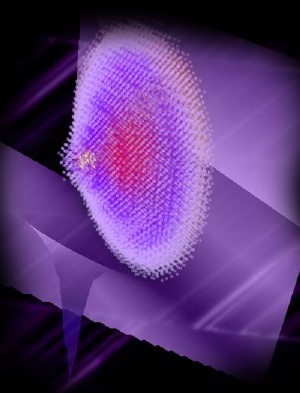Jun 27 2008
The odd behavior of a molecule in an experimental silicon computer chip has led to a discovery that opens the door to quantum computing in semiconductors.
 An international team has identified a new hybrid atom that could be used to develop quantum computers. This data visualization shows an electron density map of the material. The funnel- or vortex-shaped figure in the lower left is an arsenic atom, and the saucer-shaped image in the center is a map of an electron binding to various atoms (each dot represents one location). The yellow dots in the upper left-center are the electron in the quantum state. Credit: Purdue University image/David Ebert
An international team has identified a new hybrid atom that could be used to develop quantum computers. This data visualization shows an electron density map of the material. The funnel- or vortex-shaped figure in the lower left is an arsenic atom, and the saucer-shaped image in the center is a map of an electron binding to various atoms (each dot represents one location). The yellow dots in the upper left-center are the electron in the quantum state. Credit: Purdue University image/David Ebert
In a Nature Physics journal paper currently online, the researchers describe how they have created a new, hybrid molecule in which its quantum state can be intentionally manipulated - a required step in the building of quantum computers.
"Up to now large-scale quantum computing has been a dream," says Gerhard Klimeck, professor of electrical and computer engineering at Purdue University and associate director for technology for the national Network for Computational Nanotechnology.
"This development may not bring us a quantum computer 10 years faster, but our dreams about these machines are now more realistic."
The workings of traditional computers haven't changed since they were room-sized behemoths 50 years ago; they still use bits of information, 1s and 0s, to store and process information. Quantum computers would harness the strange behaviors found in quantum physics to create computers that would carry information using quantum bits, or qubits. Computers would be able to process exponentially more information.
If a traditional computer were given the task of looking up a person's phone number in a telephone book, it would look at each name in order until it found the right number. Computers can do this much faster than people, but it is still a sequential task. A quantum computer, however, could look at all of the names in the telephone book simultaneously.
Quantum computers also could take advantage of the bizarre behaviors of quantum mechanics - some of which are counterintuitive even to physicists - in ways that are hard to fathom. For example, two quantum computers could, in concept, communicate instantaneously across any distance imaginable, even across solar systems.
Albert Einstein, in a letter to Erwin Schrödinger in the 1930s, wrote that in a quantum state a keg of gunpowder would have both exploded and unexploded molecules within it (a notion that led Schrödinger to create his famous cat-in-a-box thought experiment).
This "neither here nor there" quantum state is what can be controlled in this new molecule simply by altering the voltage of the transistor.
Until now, the challenge had been to create a computer semiconductor in which the quantum state could be controlled, creating a qubit.
"If you want to build a quantum computer you have to be able to control the occupancy of the quantum states," Klimeck says. "We can control the location of the electron in this artificial atom and, therefore, control the quantum state with an externally applied electrical field."
The discovery began when Sven Rogge and his colleagues at Delft University of Technology in the Netherlands were experimenting with nano-scale transistors that show the effects of unintentional impurities, or dopants. The researchers found properties in the current-voltage characteristics of the transistor that indicated electrons were being transported by a single atom, but it was unclear what impurity was causing this effect.
Physicist Lloyd Hollenberg and colleagues at the University of Melbourne in Australia were able to construct a theoretical silicon-based quantum computer chip based on the concept of using an individual impurity.
"The team found that the measurements only made sense if the molecule was considered to be made of two parts," Hollenberg says. "One end comprised the arsenic atom embedded in the silicon, while the 'artificial' end of the molecule forms near the silicon surface of the transistor. A single electron was spread across both ends.
"What is strange about the 'surface' end of the molecule is that it occurs as an artifact when we apply electrical current across the transistor and hence can be considered 'manmade.' We have no equivalent form existing naturally in the world around us."
Klimeck, along with graduate student Rajib Rahman, developed an updated version of the nano-electronics modeling program NEMO 3-D to simulate the material at the size of 3 million atoms.
"We needed to model such a large number of atoms to see the new, extended quantum characteristics," Klimeck says.
The simulation showed that the new molecule is a hybrid, with the naturally occurring arsenic at one end in a normal spherical shape and a new, artificial atom at the other end in a flattened, 2-D shape. By controlling the voltage, the researchers found that they could make an electron go to either end of the molecule or exist in an intermediate, quantum, state.
This model was then made into an image by David Ebert, a professor of electrical and computer engineering at Purdue, and graduate student Insoo Woo.
Delft's Rogge says the discovery also highlights the current capabilities of designing electronic machines.
"Our experiment made us realize that industrial electronic devices have now reached the level where we can study and manipulate the state of a single atom," Rogge says. "This is the ultimate limit, you can not get smaller than that."